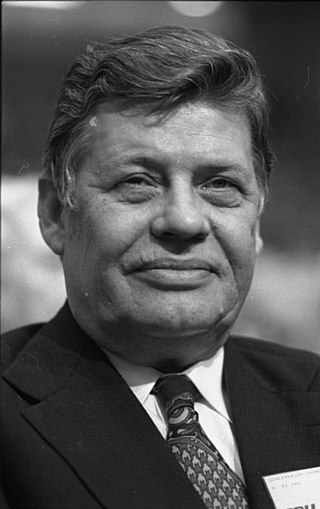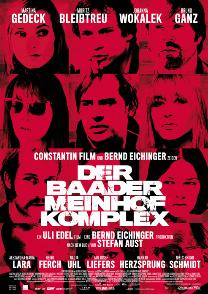
The Red Army Faction, also known as the Baader–Meinhof Group or Baader–Meinhof Gang, was a West German far-left militant group founded in 1970 and active until 1998. The RAF described itself as a communist and anti-imperialist urban guerrilla group. It was engaged in armed resistance against what it considered a fascist state. Members of the RAF generally used the Marxist–Leninist term faction when they wrote in English. Early leadership included Andreas Baader, Ulrike Meinhof, Gudrun Ensslin, and Horst Mahler. The West German government considered the RAF a terrorist organization.

Berndt Andreas Baader, was a West German communist and leader of the left-wing militant organization Red Army Faction (RAF) also commonly known as the Baader-Meinhof Group.
The German Autumn was a series of events in Germany in 1977 associated with the kidnapping and murder of industrialist, businessman, and former Schutzstaffel member Hanns Martin Schleyer, president of the Confederation of German Employers' Associations (BDA) and the Federation of German Industries (BDI), by the Red Army Faction (RAF), a far-left militant organisation, and the hijacking of Lufthansa Flight 181 by the Popular Front for the Liberation of Palestine (PFLP). The hijackers demanded the release of ten RAF members detained at the Stammheim Prison plus two Palestinian compatriots held in Turkey and US$15 million in exchange for the hostages. The assassination on 7 April 1977 of Siegfried Buback, the attorney-general of West Germany, and the failed kidnapping and then murder of the banker Jürgen Ponto on 30 July 1977, marked the beginning of the German Autumn. It ended on 18 October, with the liberation of the Landshut, the deaths of the leading figures of the first generation of the RAF in their prison cells, and Schleyer's death.
Irmgard Möller is a German former militant. She joined the Red Army Faction (RAF) in 1971. After participating in two bombings she was arrested the following year. During the German Autumn of 1977, she was one of the prisoners demanded by the RAF to be freed and was part of an alleged suicide pact in Stammheim Prison with Andreas Baader, Gudrun Ensslin and Jan-Carl Raspe. The other three died and she survived, claiming it was an assassination attempt. She was released from prison in 1994.

Hans "Hanns" Martin Schleyer was a German business executive, and employer and industry representative, and SS officer who served as president of two powerful commercial organizations, the Confederation of German Employers' Associations and the Federation of German Industries. Schleyer became a target for radical elements of the German student movement in the 1970s for his role in those business organisations, positions in the labour disputes, aggressive appearance on television, conservative anti-communist views, position as a prominent member of the Christian Democratic Union, and past as an enthusiastic member of the Nazi student movement and a former SS officer.
Sieglinde Hofmann was a German militant and member of both the Socialist Patients' Collective and the Red Army Faction.
Ingrid Schubert was a West German militant and founding member of the Red Army Faction (RAF). She participated in the freeing of Andreas Baader from prison in May 1970 as well as several bank robberies before her arrest in October 1970. She was found dead in her cell in 1977.
Siegfried Hausner was a student member of the German Socialist Patients' Collective who was sentenced to three years imprisonment in 1972 for terrorist related crimes. When he was released in 1974, like many other former members of the SPK, he joined the Red Army Faction.
Christian Klar is a former leading member of the second generation Red Army Faction (RAF), active between the 1970s and 1980s. Imprisoned in 1982 in Bruchsal Prison, he was released on 19 December 2008, after serving over 26 years of his life sentence.

Rolf Clemens Wagner was a member of the left wing terrorist organisation Red Army Faction (RAF).
Stefan Wisniewski is a former member of the Red Army Faction (RAF).

The Baader Meinhof Complex is a 2008 German drama film directed by Uli Edel. Written and produced by Bernd Eichinger, it stars Moritz Bleibtreu, Martina Gedeck, and Johanna Wokalek. The film is based on the 1985 German best selling non-fiction book of the same name by Stefan Aust. It retells the story of the early years of the West German far-left terrorist organisation the Rote Armee Fraktion from 1967 to 1977.
Waltrude Ketterer Schleyer was the widow of Hanns Martin Schleyer, a high-ranking German business executive and former member of the SS, who was murdered by the Red Army Faction in 1977.
Siegfried Haag was a member of the West German Red Army Faction (RAF). He became a leading figure of the second generation of the group.
Adelheid Schulz is a former member of the West German terrorist Red Army Faction.
Peter-Jürgen Boock is a German former terrorist of the Red Army Faction.
Angelika Speitel is a former member of the West German terrorist Red Army Faction (RAF).

Knut Detlef Folkerts is a former member of the terrorist group Red Army Faction (RAF).

Germany in Autumn is a 1978 West German anthology film about the period of 1977 known as the German Autumn, which was dominated by incidents of terrorism. The film is composed of contributions from different filmmakers, including Rainer Werner Fassbinder, Alexander Kluge, Edgar Reitz, Bernhard Sinkel, Alf Brustellin, Hans Peter Cloos, Katja Rupé, Peter Schubert and Volker Schlöndorff. It was entered into the 28th Berlin International Film Festival, where it won a Special Recognition award.







